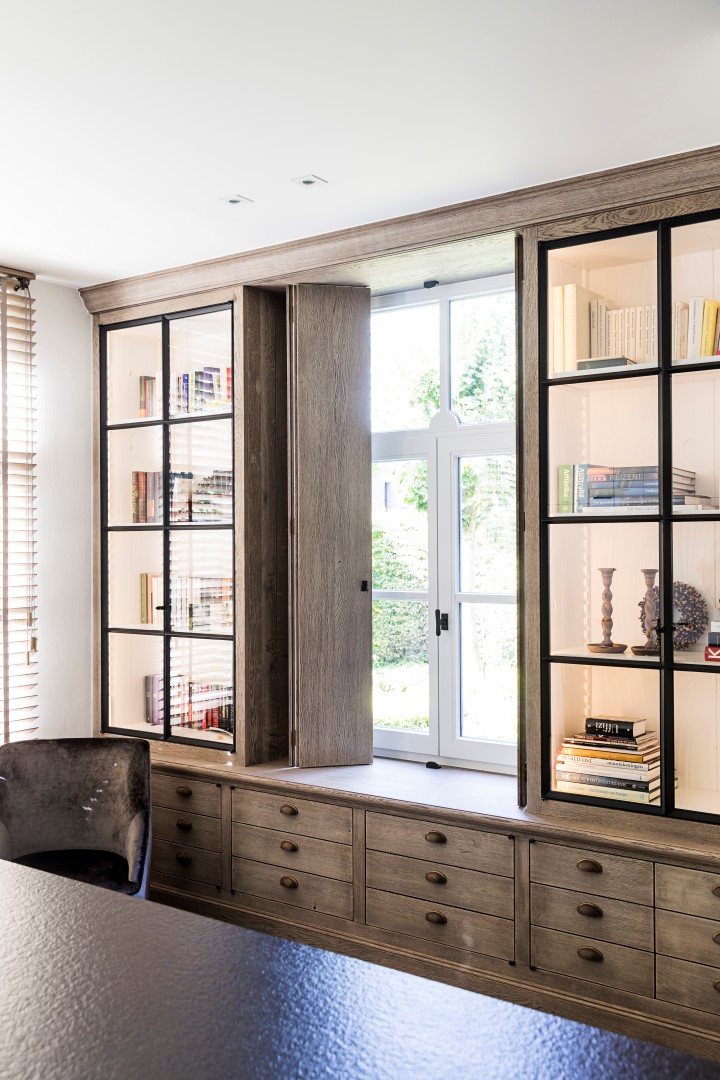What do you do when your microwave breaks down? Obviously, you immediately refurbish your entire ground floor! It may sound like a joke, but that’s the story behind this refurbishment in a nutshell.
When the owners of this Kempen villa built their dream house some twenty years ago, they had not yet thought about adding to their family. But, just under a quarter of a century later, it was time to adapt the house to the changed family and work situation. With adult children, children-in-law and future grandchildren, there needed to be enough space to host the entire extended family.
Interior designer Paul Rijs: ‘At one point, Wil Brosens of the eponymously named interior design company in Hoogstraten, asked me to take a look at the residence of one of his clients. They wanted to make some changes to its interior. The interior layout no longer met the needs of their large family, with its grown-up children, partners and grandchildren. Also, the owners’ work situation had changed, and the original home-based medical practice was no longer being used. In order to host everyone at family parties, a transformation was needed. In addition, several kitchen appliances were faulty and the kitchen was outdated. So, when the microwave broke down, the time to take action had finally come. Half an hour after being welcomed by the owners and walking around their house, I could already feel and sense what could be changed and improved. Moreover, the interaction with the clients was very spontaneous and warm, and immediately felt comfortable. Initially, the owners thought of adding an extension to expand the ground floor. However, this turned out to be unnecessary, as there was plenty of space that was not being used to its fullest potential. The biggest problem was the dining room; they wanted to be able to accommodate more guests. As in many villas from that period, the living and dining rooms are interconnected; my standard practice now is to avoid that.
There was also a service entrance with a waiting room and a doctor’s office. But the owners only used this as an office space. As a result, many of the rooms in the house were no longer being used efficiently. Also, I am a proponent of ‘using every square metre’. This wasn’t happening here. In the waiting room, for example, there was some library furniture with a chair that I suspected was never used; it was merely ornamental. Behind the existing kitchen was a large laundry room with access to the garden and basement. In my opinion, it was far too large for its purpose. Initially, from the entrance hall, you walked straight into the dining room, which effectively served as a status symbol. Everyone would sit down together at the table to celebrate parties and birthdays. But, at other times, its full potential was wasted. Moreover, the table had become too small to accommodate the entire family. That was a point I wanted to address. The single door to the kitchen also had to be widened. By doing that, you would have a much better view from the dining room to the beautiful garden. The sitting area by the fireplace was relatively small and badly positioned. On one side was a built-in TV cabinet, and on the other side was the fireplace. I wanted to open up the ground floor more and, above all, create a balance between an aesthetically pleasing layout and optimal use of all the rooms. The former consulting room and waiting area were replaced by the new kitchen. The space gained by moving the original kitchen provided a spacious dining room with plenty of light and a magnificent view of the garden. A sitting area was added to the dining room, with a fireplace and a few chairs, creating a cosy atmosphere. It has become the ideal space in which to welcome the many guests who regularly visit.
For Paul Rijs and his right-hand Ilse Wouters, this approach was an enormous gamble, because, in order to implement his plans, almost the entire ground floor needed to be redesigned, and a number of walls demolished and rebuilt in different areas. However, the owners were immediately enthusiastic about their ideas, and Paul and Ilse were given the go-ahead. The large laundry room made way for an entrance hall from the garden, with a passageway to the new kitchen. The waiting room was replaced by a new, though smaller, laundry room. Now this house exudes a completely timeless yet contemporary atmosphere, and there is plenty of room for extensive family reunions and cosy dinners with guests.
The warm atmosphere is accentuated by the fireplace in the dining room. This was supplied and installed by de la Meilleure in Maldegem, a company with a fitting name, as it was designated the ‘Most Friendly Business in the Municipality’. Case manager Katrien says: ‘Because the dining room occupies such an important place in the lives of the owners in this project, it was important to include the additional fireplace. It enhances the atmosphere and conviviality of dining together. We installed a Kal-Fire gas fire, type GP75/59F, in the dining room. This is a new type of closed combustion high-efficiency gas fire that comes with a designer rear wall. Particularly unique is the realistic rendering of the flames. Thanks to the use of ceramic logs and a flame that genuinely seems to originate from the wood itself, it almost perfectly simulates the image of a real fireplace, without any of the disadvantages. No carrying of logs, no ash and a fire that lights instantly and heats quickly. Thanks to the remote control, using this type of fireplace is child’s play. The sleek, frameless glass perfectly complements the dining room’s style. The fireplace is not overly prominent, but contributes discretely to the atmosphere of the room.’

